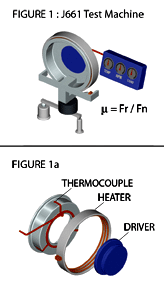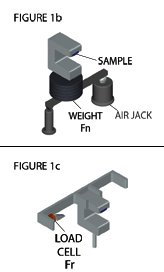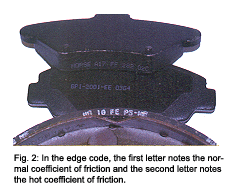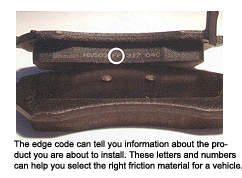Unlock The Code
Just about every brake pad or shoe you install has a cryptic code printed on the side of the friction material. As a technician, being able to read this code is just as important as the Dewey Decimal System is to a librarian or an ancient writing is to a symbologist. The Edge Code can tell you information about the product you are about to install. These letters and numbers can help you select the right friction material for a vehicle and its driver.
Do Not Despair: Edge Code is a language written by engineers, federal entities and industry associations. Like any language, edge coding has its own grammar that has been defined by standardized vehicle and laboratory tests.
Opening Your Eyes to the Decryption
If you are to take one thing away from this article, it should be how to read the letters that correspond with the friction levels of the brake compound. These are the two letters that are midway through the code. But, to understand the letters, you must first understand the tests behind the letters.
 Teachings from the Society
Teachings from the Society
The coefficient of friction and resistance to fading is measured using Society of Automotive Engineers (SAE) practice J661 and marked with SAE Practice J688 (truck standard). Stay with me here, when you see a SAE JXXX code or practice dont think that it is useless to a technician. Keep in mind that when SAE publishes these standards it has been reviewed and tweaked by all concerned parties like OEMs, suppliers and governmental bodies in some cases. In the cases of J661 and J688, it has direct bearing on the aftermarket technician.
The purpose of J661 and J688 is to establish a uniform laboratory procedure for securing and reporting the friction and wear characteristics of brake linings. The performance data obtained can be used for in-plant quality control and for the quality assessment of incoming shipments by the purchasers of brake linings. But, the data is also used in determining the edge code and the right friction material for a vehicle.
The Testing Begins
J661 has its roots in a Ford test that was developed in the 1960s. This is why the test takes place in a simulated drum brake. It is a simple test that just about every friction material formulation has to endure.
SAE Practice J661 and J688 testing procedure takes place on a machine (See Figure 1) that contains an 11-inch drum with three temperature sensors. The drum can also be heated during the test. But, the drum is turned at a constant speed (Figure 1a).
 A fixture to contain a 1-inch /25.4 mm square by 0.24-inch/6 mm thick sample of friction material with a radius to match the drum, and weights to apply pressure to the sample. An air jack is used to apply and release the weights on the fixture (Figure 1b). A load cell is attached to the fixture to measure the force generated by the friction material when the drum is turned (Figure 1c).
A fixture to contain a 1-inch /25.4 mm square by 0.24-inch/6 mm thick sample of friction material with a radius to match the drum, and weights to apply pressure to the sample. An air jack is used to apply and release the weights on the fixture (Figure 1b). A load cell is attached to the fixture to measure the force generated by the friction material when the drum is turned (Figure 1c).
The test procedure consists of 11 tests that are run in succession. The normal force placed on the sample is 150 lbs. The rotational speed of the drum is 417 rpm. The load cell measures force in lbs / sq inch. The heating elements are capable of producing drum temperatures of 200 to 650 F.
The Table of Coefficients
The SAE Practice J668 and J661 for the edge code on friction material notes the normal coefficient of friction and hot coefficient of friction or fade resistance. Letters are used to note the coefficient of friction as shown in Table 1.
Taking the Tests to Task
Test 1 – Baseline: The load is applied to the drum for 10 seconds and released for 20 seconds for 20 applications.
Test 2 – First Fade: The load is applied continuously for 10 minutes or until 550 F. The coefficient of friction is recorded with each increase in temperature.
Test 3 – First Recovery: apply load for 10 seconds at 100 F increment as the drum cools.
Test 4 – Wear Measurement: The height of the sample holder is measured.
Test 5 – Wear Run: Apply load for 20 seconds and release for 10 seconds for 100 applications.
Test 6 – Wear Measurement: The height of the sample holder is measured.
Test 7 – Second Fade: The load is applied continuously for 10 minutes or until 650 F. The coefficient is recorded with each increase in temperature of 50 F.
Test 8 – Second Recovery: Apply the load for 10 seconds at 100 F increment as the drum cools from 600 to 200 F.
Test 9 – Baseline: The load is applied to the drum for 10 seconds and released for 20 seconds for 20 applications with a drum temperature of 180 to 220 F.
Test 10 – Wear Measurement: The height of the sample holder is measured.
Test 11 – Mass and Thickness: The weight and thickness of the sample is measured.
Reading the codes
 In the edge code, the first letter notes the normal coefficient of friction and the second letter notes the hot coefficient of friction (See Figure 2). The code appears in 0.25-inch letters on the edge of the friction material.
In the edge code, the first letter notes the normal coefficient of friction and the second letter notes the hot coefficient of friction (See Figure 2). The code appears in 0.25-inch letters on the edge of the friction material.
The coefficient of friction is determined using SAE Practice J661.
Wear measurement results are not indicated in the edge coding and should be an important result for the developer of the friction material. The aftermarket rating of replacement shoes and pads may have some relation to the ware characteristics of that particular assembly.
As for the edge code, the results are directly tied to the Formula of m = Fr / Fn where Fn is 150 lbs and Fr is the pressure recorded by the load cell during a normal or hot test sequence. For example, an average load cell recording of 42 lbs / sq inch during a test would produce an m of 0.28 that would relate to an E rating on the edge code.
 Obeying the Standards Set Forth From FMVSS
Obeying the Standards Set Forth From FMVSS
Imagine you are working at an automotive plant assembling cars. In rushes a federal inspector demanding the keys to a random vehicle for brake testing. OK, it is not that dramatic, but it happens on a regular basis. This testing insures that new vehicles meet the Federal Motor Vehicle Safety Standards (FMVSS) standards.
The FMVSS standards 105 and 135 set performance standards for vehicles equipped with hydraulic and electric braking systems. Unlike SAE J661 and J668, the FMVSS tests take place on the vehicle, which makes it a dynamic test.
FMVSS 105 includes system configurations and braking performance for both service and parking brakes. Parking brakes must hold a vehicle in forward and reverse directions on a 30% grade for five minutes.
FMVSS 135 basically requires light vehicles (GVWR of 10,000 pounds or less) to stop, also on a high coefficient of friction pavement and with properly working brakes, in 215 feet (the actual requirement is 230 feet from 100 KPH).
Understand that the OEMs are constantly tuning and testing friction materials so that a vehicle can meet or exceed FMVSS 105 and 135. Taking chances with a replacement friction material that does not match the OEMs performance curve can mean disaster for the person who throws away the box.
Secrets Shared with the Aftermarket
Back in 1992, the Brake Manufacturers Council began funding a Society of Automotive Engineers (SAE) task force to develop a new laboratory dyno test procedure for evaluating brake linings. In 1994, SAE published the J1652 test for evaluating friction materials on front disc brakes. Then in August 1999, SAE published the J2430 test procedure for testing linings on the front and rear brakes together.
The J2430 is a test that any manufacturer can use to evaluate their products. The test is very detailed and takes about 15 hours to complete. It does not have pass/fail standards, but is designed to reveal how a given set of linings compares to the FMVSS 135 requirements for new brakes.
Greening Testing Laboratories in Detroit also has developed lab tests for certifying the performance of brake linings for several aftermarket brake suppliers. Its Dual Dynamometer Differential Effectiveness Analysis (D3EA) test procedure measures and compares the various performance windows (stopping power, fade resistance, etc.) of aftermarket linings against the OEM linings on a given vehicle platform. As long as the aftermarket linings fall within specified limits, they are certified as being OE-equivalent in terms of braking performance.
|
Friction as a Force
As taught in the ancient times and still holding true today, friction is a resistive force that prevents two objects from sliding freely against each other. The coefficient of friction: The Greek letter (pronounced mew) is a number that is the ratio of the resistive force of friction (Fr) divided by the normal or perpendicular force (Fn) pushing the objects together. It is represented by the equation: m = Fr / Fn. |
|
CODING for J668 and J661
|
|
| Code Letter | Friction Coefficient |
| C | Not over 0.15 |
| D | Over 0.15, but not over 0.25 |
| E | Over 0.35, but not over 0.45 |
| F | Over 0.45, but not over 0.55 |
| G | Over 0.45, but not over 0.55 |
| H | Over 0.55 |
| Z | Unclassified |











